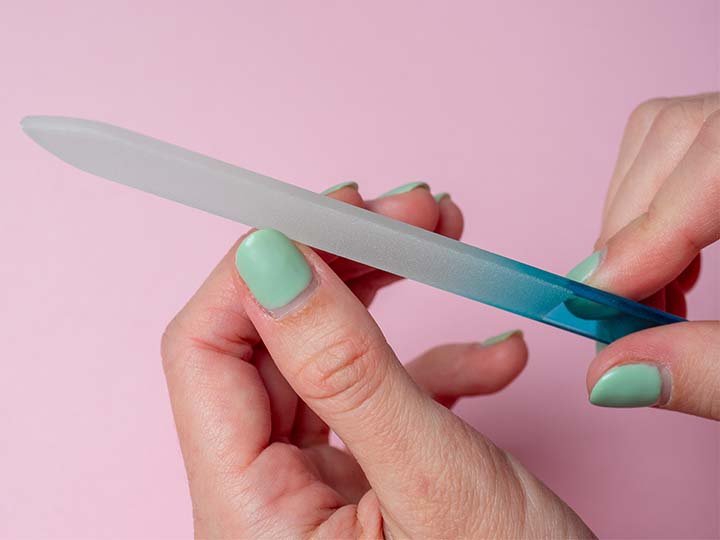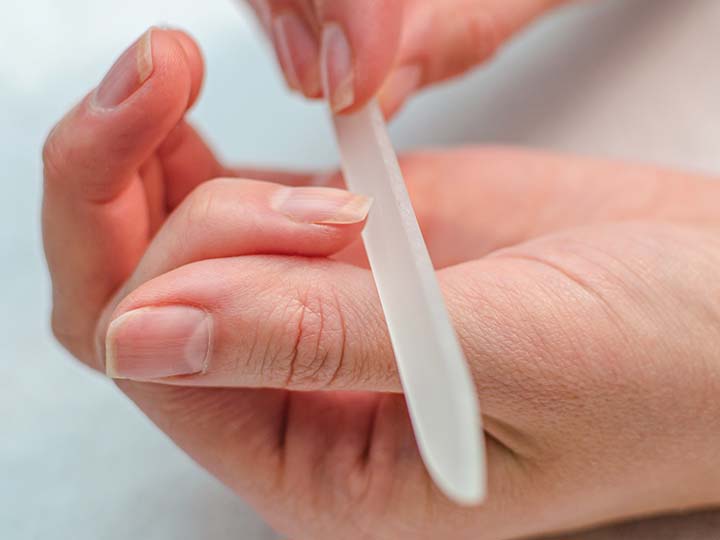Struggling to Get That Perfect Nail Shape?
Ever file your nails only to end up with jagged edges or worse, split tips? You’re not alone! Knowing how to use a nail file properly can make all the difference between perfectly shaped nails and a manicure disaster. Whether you’re aiming for rounded edges or sharp, square tips, the technique you use is just as important as the tool itself.
In this guide, we’ll show you how to get the best results from your nail file, keep your nails healthy, and avoid common mistakes that can damage your nails. Ready to master the art of nail filing?
Why Proper Filing Matters
Before we jump into the “how-to,” let’s quickly go over why proper nail filing is so important.
1. Prevents Nail Damage
Filing your nails the wrong way can cause them to weaken, split, or crack. By learning how to use a nail file properly, you protect your nails from unnecessary damage and keep them strong.
2. Creates a Smooth, Polished Finish
Proper filing helps shape your nails evenly, giving them a neat and polished look. This makes your nails not only look better but also less prone to snagging on fabrics or chipping.
3. Encourages Healthy Nail Growth
Filing your nails correctly promotes even growth and keeps your nails at a manageable length. It also removes rough edges that could lead to peeling or breakage.
How to Use a Nail File: Step-by-Step Guide
Achieving the perfect nail shape starts with the right technique. Here’s a simple step-by-step guide on how to use a nail file properly:
Step 1: Choose the Right Nail File
There are several types of nail files to choose from, including emery boards, glass files, and metal files. Emery boards are the most common, but they can be rough on nails if used improperly. Glass files are gentler and long-lasting, making them a great choice for natural nails.
- Tip: If you have fragile or thin nails, opt for a fine-grit file (240-grit or higher). For thicker or stronger nails, a medium-grit file (180-grit) will work well.
Step 2: Start with Clean, Dry Nails
Before filing, make sure your nails are clean and completely dry. Filing wet nails can cause them to bend or tear, which weakens the nail and makes it more likely to split.
- Tip: Always file your nails after removing any polish or product. Filing over polish can damage both the file and your nails.
Step 3: File in One Direction
The most important rule when filing your nails is to file in one direction. Avoid the common mistake of sawing back and forth, as this can cause the nails to splinter and weaken over time.
- How to do it: Start at one corner of the nail and gently file toward the center using smooth, even strokes. Repeat this motion from the other corner until the desired shape is achieved.
Step 4: Find Your Desired Shape
There are several nail shapes to choose from, depending on your personal preference:
- Round or Oval: Ideal for shorter nails, round and oval shapes are great for preventing snags and are less prone to breaking.
- Square: This shape gives a more modern look and works well for longer nails but may be prone to snagging if not filed correctly.
- Squoval: A hybrid of square and oval, this shape offers a polished look while being durable.
- Almond or Stiletto: Best for those with longer nails, these dramatic shapes require more care to prevent breakage.
- Tip: If you’re not sure which shape suits you, start with a softer, round shape, which is easy to maintain and suits most nail types.
Step 5: Smooth the Edges
After you’ve shaped your nails, it’s important to smooth out the edges to avoid roughness or snagging. Use a fine-grit file or a buffer to lightly go over the tips and smooth any sharp or uneven areas.
- Tip: Use a buffer to lightly smooth the tops of your nails as well. This will give your nails a healthy shine and remove any ridges.
Common Mistakes to Avoid When Using a Nail File
Even with the best intentions, it’s easy to make mistakes while filing your nails. Here are some common mistakes to avoid:
1. Filing Back and Forth
As mentioned earlier, sawing your nails back and forth weakens them and can lead to splitting. Stick to the one-direction technique for smooth, damage-free nails.
2. Over-Filing the Sides
Filing too much on the sides of your nails can weaken them and increase the risk of breakage or ingrown nails. Focus on shaping the tip of the nail, rather than over-filing the sides.
3. Filing Wet Nails
Filing nails when they’re wet or soft can cause them to bend or tear. Always make sure your nails are completely dry before filing.
4. Using the Wrong Grit
Using a file that’s too rough (low-grit) can be harsh on your nails, especially if they’re thin or brittle. Choose a higher-grit file for gentle shaping, particularly for natural nails.
Nail File Care: How to Keep Your Tool in Top Shape
Your nail file works hard, and like any tool, it needs proper care to last. Here’s how to keep your nail file clean and in good condition:
1. Clean Your Nail File Regularly
Whether you’re using an emery board, glass, or metal file, it’s important to clean your nail file regularly to remove nail dust and bacteria. For glass or metal files, simply wash them with warm, soapy water and let them air dry. For emery boards, you can gently brush away the dust with a toothbrush.
2. Store It Properly
Keep your nail file in a clean, dry place to avoid moisture buildup, which can cause it to deteriorate or harbor bacteria. For glass files, consider using a protective case to avoid breakage.
3. Replace Emery Boards Frequently
Emery boards wear down over time, so it’s important to replace them once they become smooth or less effective. Glass and metal files last much longer and can be reused after cleaning.
Wrapping It Up
Knowing how to use a nail file properly is the key to achieving perfectly shaped nails without causing damage. By following the one-direction technique, choosing the right file, and taking care of your nail tools, you’ll enjoy smoother, stronger, and healthier nails.
Whether you’re going for a soft round shape or a sharp square edge, mastering the basics of nail filing will ensure your nails always look their best. With a little practice, you’ll be shaping like a pro in no time!
Achieve flawless beauty effortlessly. Explore Mersi for your perfect look!
FAQs
Q1: How often should I file my nails?
Filing once a week is generally a good practice for maintaining your nail shape. If your nails grow quickly or you notice rough edges, you may need to file more frequently.
Q2: Is it better to file nails wet or dry?
Always file your nails when they’re dry. Wet nails are more fragile and prone to tearing, which can weaken them.
Q3: What’s the best nail shape for preventing breakage?
Round or oval shapes are ideal for preventing breakage, as they have no sharp edges that are more prone to snagging or chipping.
Q4: Can I use the same file for my toenails and fingernails?
It’s best to keep separate files for your toenails and fingernails to avoid cross-contamination and keep both sets of nails healthy.
Q5: How do I clean my nail file?
For glass and metal files, clean them with warm, soapy water and let them air dry. Emery boards can be gently brushed with a toothbrush to remove nail dust, but they should be replaced regularly.





Leave a comment
This site is protected by hCaptcha and the hCaptcha Privacy Policy and Terms of Service apply.